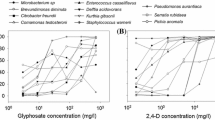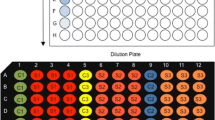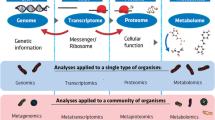Abstract
Rapid microscale toxicity tests make it possible to screen large numbers of compounds and greatly simplify toxicity identification evaluation and other effect directed chemical analyses of effluents or environmental samples. Tests using Vibrio fischeri (such as Microtox®) detect toxicants that cause non-specific narcosis, but are insensitive to other important classes of contaminants. The microbial assay for risk assessment (MARA) is a 24 h multi-species test that seeks to address this problem by using a battery of ten bacteria and a fungus. But there has been little independent evaluation of this test, and there is no published information on its sensitivity to pesticides. Here, we assess the performance of MARA using a range of toxicants including reference chemicals, fungicides and environmental samples. Mean MARA microbial toxic concentrations and IC20s (20% Inhibitory concentrations) indicate the toxicant concentrations affecting the more sensitive micro-organisms, while the mean IC50 (50% Inhibitory concentration) was found to be the concentration that was toxic to most MARA species. For the two fungicides tested, the yeast (Pichia anomalia) was the most sensitive of the ten MARA species, and was more sensitive than the nine other yeasts tested. The test may be particularly valuable for work with fungicides. Mean MARA IC50s were comparable to values for nine other yeast species and the lowest individual IC50s for each toxicant were comparable to reported IC50s for Daphnia magna, Selenastrum capricornutum and Microtox® bioassays. MARA organisms exhibited more variable sensitivities, with the most sensitive organism being different for different samples, enhancing the likelihood of toxicity detection and giving a toxicity “fingerprint” that may help identify toxicants. The test, therefore, has great potential and would be valuable for ecotoxicological testing of pollutants.



Similar content being viewed by others
References
Benfenati E, Barcelo D, Johnson I, Galassi S, Levsen K (2003) Emerging organic contaminants in leachates from industrial waste landfills and industrial effluent. TrAC Trend Anal Chem 22(10):757–765
Brack W (2003) Effect-directed analysis: a promising tool for the identification of organic toxicants in complex mixtures? Anal Bioanal Chem 377(3):397–407
Cabral MG, Viegas CA, Teixeira MC, Sa-Correia I (2003) Toxicity of chlorinated phenoxyacetic acid herbicides in the experimental eukaryotic model Saccharomyces cerevisiae: role of pH and of growth phase and size of the yeast cell population. Chemosphere 51(1):47–54
Cascorbi I, Bittrich H, Ricklinkat J, Voss W, Seyfarth A, Foret M (1993) Effects of a heterogeneous set of xenobiotics on growth and plasma-membranes of mammalian and fungal cell-cultures. Ecotoxicol Environ Saf 26(1):113–126
DeLorenzo ME, Scott GI, Ross PE (2001) Toxicity of pesticides to aquatic microorganisms: A review. Environ Toxicol Chem 20(1):84–98
Fai PB, Grant A (2009a) A comparative study of Saccharomyces cerevisiae sensitivity against eight yeast species sensitivities to a range of toxicants. Chemosphere 75(3):289–296
Fai PB, Grant A (2009b) A rapid resazurin bioassay for assessing the toxicity of fungicides. Chemosphere 74:1165–1170
Falih AM (1998) Comparative toxicity of heavy metals to some yeasts isolated from Saudi Arabian soil. Bioresour Technol 64(3):193–198
Farre M, Barcelo D (2003) Toxicity testing of wastewater and sewage sludge by biosensors, bioassays and chemical analysis. TrAC Trend Anal Chem 22(5):299–310
Farre M, Martinez E, Barcelo D (2007) Validation of interlaboratory studies on toxicity in water samples. TrAC Trend Anal Chem 26(4):283–292
Fochtman P, Raszka A, Nierzedska E (2000) The use of conventional bioassays, microbiotests, and some “rapid” methods in the selection of an optimal test battery for the assessment of pesticides toxicity. Environ Toxicol 15(5):376–384
Gabrielson J, Kuhn I, Colque-Navarro P, Hart M, Iversen A, McKenzie D, Mollby R (2003) Microplate-based microbial assay for risk assessment and (eco)toxic fingerprinting of chemicals. Anal Chim Acta 485(1):121–130
Greenwood R, Mills GA, Roig B (2007) Introduction to emerging tools and their use in water monitoring. TrAC Trend Anal Chem 26(4):263–267
Leroux P (2003) Modes d’action des produits phytosanitaires sur les organismes pathogenes des plantes: Mode of action of agrochemicals towards plant pathogens. Comptes Rendus Biologies 326(1):9–21
Manusadzianas L, Balkelyte L, Sadauskas K, Blinova I, Pollumaa L, Kahru A (2003) Ecotoxicological study of Lithuanian and Estonian wastewaters: selection of the biotests, and correspondence between toxicity and chemical-based indices. Aquat Toxicol 63(1):27–41
Ocampo-Duque W, Sierra J, Ferré-Huguet N, Schuhmacher M, Domingo JL (2008) Estimating the environmental impact of micro-pollutants in the low Ebro River (Spain): An approach based on screening toxicity with Vibrio fischeri. Chemosphere 72(5):715–721
Papaefthimiou C, Cabral MD, Mixailidou C, Viegas CA, Sa-Correia I, Theophilidis G (2004) Comparison of two screening bioassays, based on the frog sciatic nerve and yeast cells, for the assessment of herbicide toxicity. Environ Toxicol Chem 23(5):1211–1218
Parvez S, Venkataraman C, Mukherji S (2006) A review on advantages of implementing luminescence inhibition test (Vibrio fischeri) for acute toxicity prediction of chemicals. Environ Int 32(2):265–268
Pessala P, Schultz E, Nakari T, Joutti A, Herve S (2004) Evaluation of wastewater effluents by small-scale biotests and a fractionation procedure. Ecotoxicol Environ Saf 59(2):263–272
Reteuna C, Vasseur P, Cabridenc R (1989) Performances of 3 Bacterial Assays in Toxicity Assessment. Hydrobiologia 188:149–153
Ribeiro IC, Verissimo I, Moniz L, Cardoso H, Sousa MJ, Soares A, Leao C (2000) Yeasts as a model for assessing the toxicity of the fungicides Penconazol, Cymoxanil and Dichlofluanid. Chemosphere 41(10):1637–1642
Treco DA, Lundblad V (1996) Yeast. In: Current protocols in molecular biology (13). Wiley. New York
Wadhia K (2008) ISTA13—International Interlaboratory Comparative Evaluation of Microbial Assay for Risk Assessment (MARA). Environ Toxicol 23:626–633
Wadhia K, Thompson KC (2007) Low-cost ecotoxicity testing of environmental samples using microbiotests for potential implementation of the Water Framework Directive. TrAC Trend Anal Chem 26(4):300–307
Wadhia K, Dando T, Thompson KC (2007) Intra-laboratory evaluation of Microbial Assay for Risk Assessment (MARA) for potential application in the implementation of the Water Framework Directive (WFD). J Environ Monitor 9:953–958
Wells PG, Depledge MH, Butler JN, Manock JJ, Knap AH (2001) Rapid toxicity assessment and biomonitoring of marine contaminants - Exploiting the potential of rapid biomarker assays and microscale toxicity tests. Mar Pollut Bull 42(10):799–804
Acknowledgments
We are grateful to the UK National Collection of Industrial, food and Marine Bacterial (NCIMB) and Alcontrol Laboratory for providing training and all the materials and equipment for the MARA test free of charge.
Author information
Authors and Affiliations
Corresponding author
Rights and permissions
About this article
Cite this article
Fai, P.B., Grant, A. An assessment of the potential of the microbial assay for risk assessment (MARA) for ecotoxicological testing. Ecotoxicology 19, 1626–1633 (2010). https://doi.org/10.1007/s10646-010-0548-2
Accepted:
Published:
Issue Date:
DOI: https://doi.org/10.1007/s10646-010-0548-2




